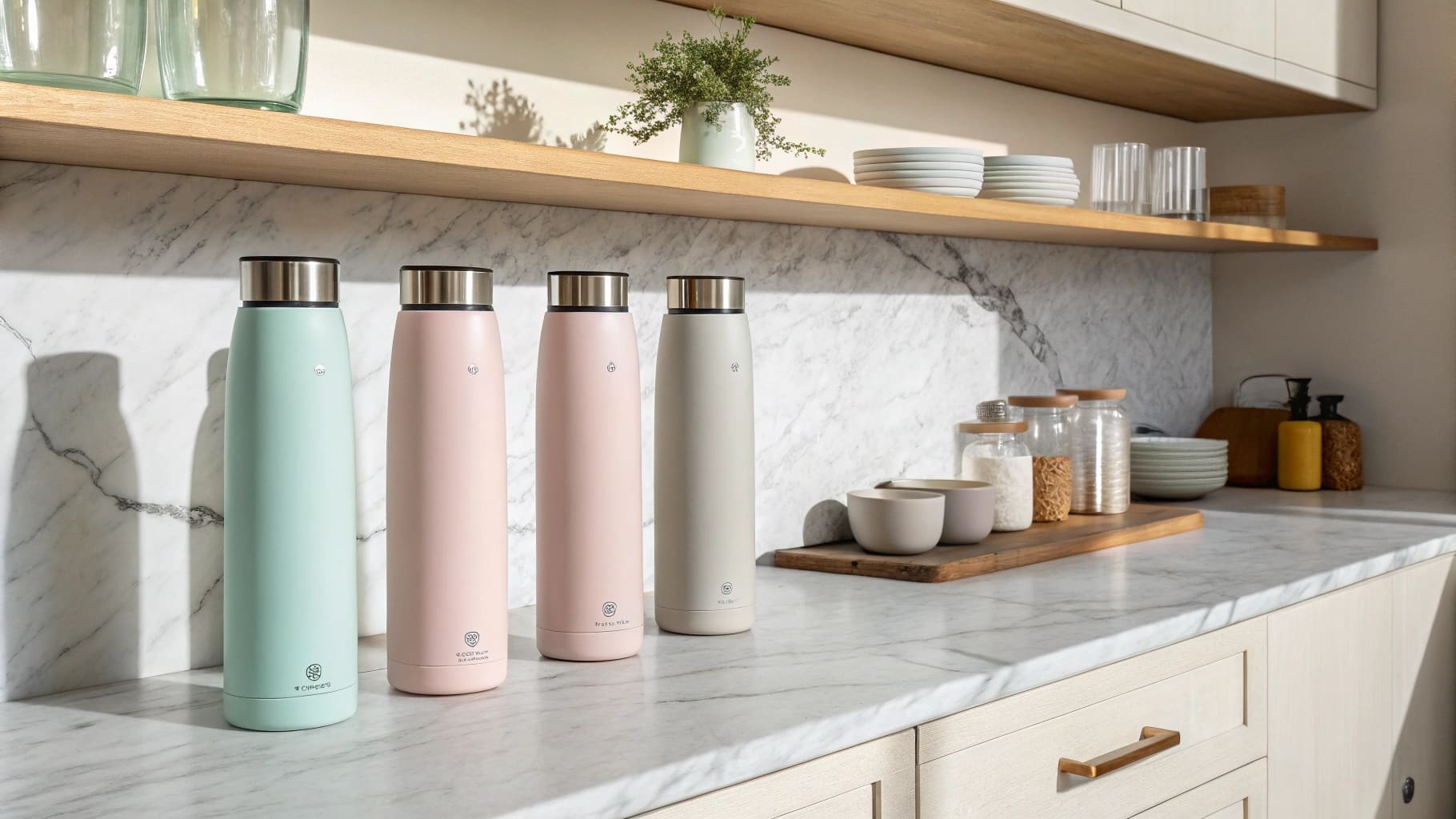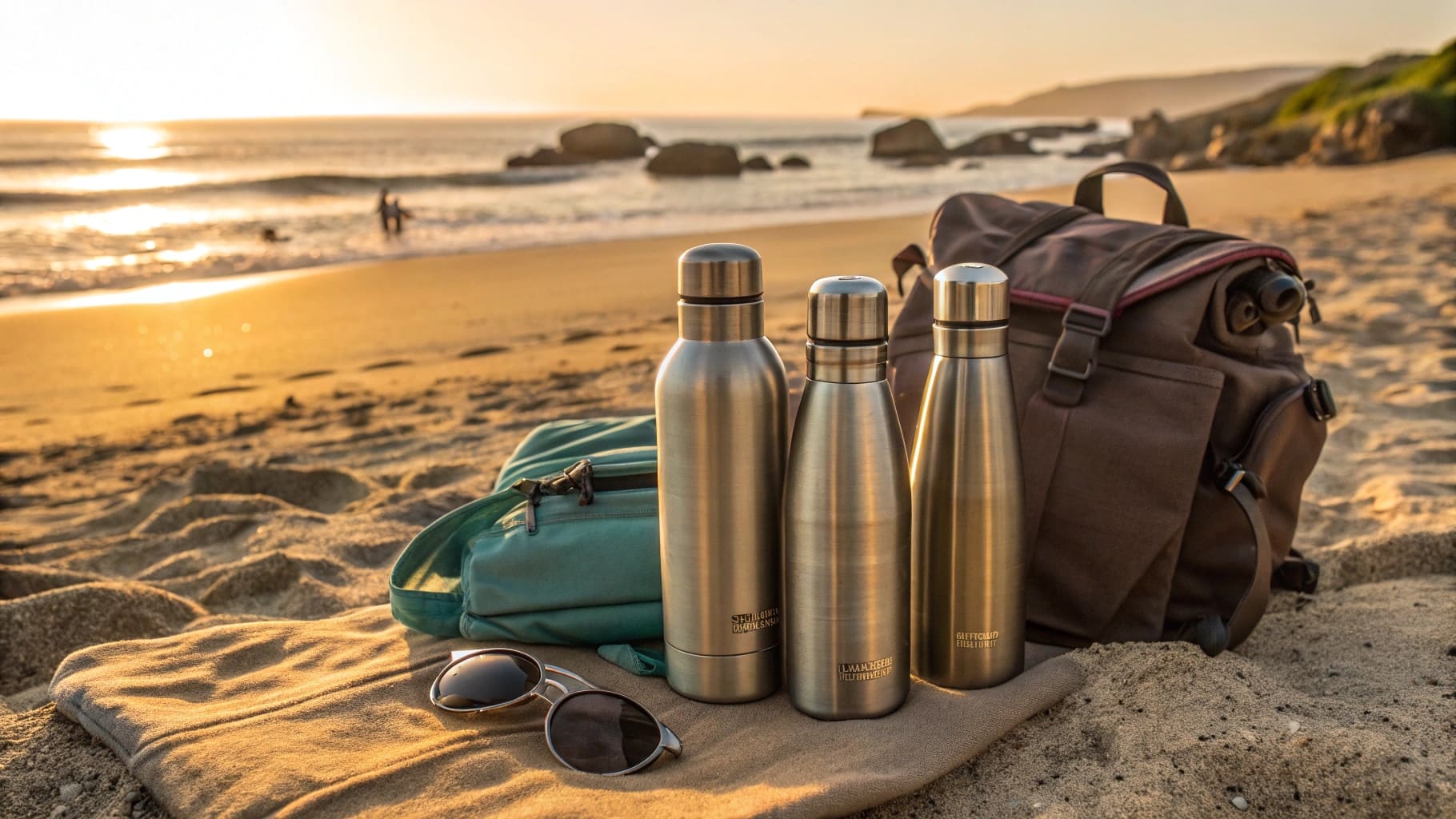Choosing bottle materials is confusing. Health, lifespan, and taste matter. I will explain the key differences to help you pick the best option.
Copper bottles have traditional appeal. But stainless steel offers better safety, lasts longer, and keeps water tasting pure. For most, stainless steel is the superior choice.

As someone in the B2B bottle business, I often get asked about material choices. Many clients, like Mark Shenng from Canada, are procurement officers or startup bosses. They need reliable products. They want to avoid issues like delayed shipments or certificate fraud, which Mark has faced. Understanding the nuances between copper and stainless steel is vital. It impacts product quality and customer satisfaction. So, let's look closer at these materials. This will help you make an informed decision for your business.
Which is better, a copper or stainless steel water bottle?
Deciding between copper and steel is tough. A wrong choice can affect sales. I can help you see which material is generally better for your business.
For B2B, stainless steel is usually better. It is safer, more durable, and does not change water taste. Copper has niche appeal but more practical downsides.

When I talk to business owners like Mark, who imports stainless steel water bottles to Canada, the conversation always turns to practical benefits. Mark is very sensitive to quality but also looks for competitive pricing. He needs a product that his customers will love and that won't cause him headaches.
Let's break down why stainless steel often wins for B2B:
- Health and Safety: Food-grade stainless steel, like the 304 type we use at Icobottle, is inert. This means it doesn't react with liquids. It won't leach chemicals or metals into the water. This is a huge selling point. Customers are more health-conscious than ever.
- Durability: Stainless steel is tough. It resists dents, scratches, and rust. This means a longer product life. For a business, this means fewer returns and happier customers.
- Taste Neutrality: Stainless steel does not impart any flavor to the water. Water tastes like water. This is crucial for products that will be rebranded and sold at a premium, like Mark does.
- Maintenance: Stainless steel bottles are easy to clean. Many are dishwasher safe. Copper bottles, on the other hand, tarnish and need regular, careful cleaning.
- Customization: We can easily customize stainless steel bottles with logos and various colors. This is key for branding.
Copper bottles do have a certain allure. They are linked to Ayurvedic traditions, which suggest health benefits from storing water in copper. However, from a B2B perspective, the practical issues often outweigh this. As I'll discuss later, copper can leach into water. It can also give water a metallic taste. It's a softer metal, so it dents more easily. For procurement officers who need consistent quality and minimal issues, stainless steel is generally the more reliable option.
Here’s a simple comparison:
| Feature | Stainless Steel (e.g., 304) | Copper |
|---|---|---|
| Health Safety | Excellent (inert) | Potential leaching risk, especially acidic |
| Durability | Very High (resists dents, rust) | Moderate (softer, can dent, tarnishes) |
| Taste Impact | None (neutral) | Can impart a metallic taste |
| Maintenance | Low (easy to clean) | High (requires polishing, careful cleaning) |
| B2B Suitability | High (reliable, customizable) | Niche (traditional appeal, higher care) |
For someone like Mark, who focuses on quality inspection and certification, stainless steel offers a more straightforward path to a trustworthy product.
What are the downsides of copper water bottles?
Copper bottles look unique. But are there hidden problems? Understanding potential downsides is key before investing in them for your business or customers.
Copper can leach into water, especially if stored long or if water is acidic. This can be a health risk and often creates a metallic taste.

I've seen businesses interested in copper's traditional appeal. However, it's my job at Icobottle to provide a full picture, especially for B2B clients like Mark who prioritize quality and safety. The downsides of copper are significant.
- Copper Leaching and Health Concerns: This is the biggest issue. Copper is a heavy metal. Our bodies need a tiny amount of it. But too much copper can be harmful. The World Health Organization has guidelines for copper in drinking water. If water, especially acidic water (like lemon water), sits in a copper bottle for a long time, copper ions can dissolve into the water. Over time, excessive copper intake can lead to problems like nausea, vomiting, or even liver damage in severe cases. For a business, selling a product with potential health risks is a serious liability. This directly relates to Mark's pain point about certificate fraud; ensuring product safety is paramount.
- Metallic Taste: Many people report that water stored in copper bottles takes on a distinct metallic taste. While some might not mind, many consumers find this unpleasant. If you're selling a premium beverage container, the last thing you want is for it to spoil the taste of the drink. This could lead to customer dissatisfaction.
- Durability and Tarnishing: Copper is a relatively soft metal. This means copper bottles are more prone to denting and scratching than stainless steel bottles. Also, copper naturally oxidizes and tarnishes over time. It develops a patina. While some like this aged look, it requires regular polishing with special cleaners to maintain a shiny appearance. This is extra maintenance for the end-user, which isn't ideal. I remember a potential client who initially wanted copper. After we discussed the care requirements and the risk of customer complaints about tarnishing, he decided stainless steel was a safer bet for his brand.
- Not Suitable for All Beverages: Because of the leaching risk with acidic liquids, copper bottles are generally recommended only for plain water. This limits their versatility compared to stainless steel, which can hold almost any beverage.
For B2B buyers, these downsides mean potential customer complaints, returns, and damage to brand reputation. It's why we at Icobottle always emphasize the reliability and safety of food-grade stainless steel.
What is the best material for a water bottle for taste?
Water tastes bad from some bottles. This ruins your drink. You want a bottle that keeps your water tasting pure and fresh, right?
Stainless steel is generally the best material for taste. It is inert and does not leach any flavors, ensuring your water tastes exactly as it should.

When Mark considers products for his distribution business in Canada, taste is a subtle but critical factor. He's rebranding items and selling them at a premium. If the bottle itself alters the taste of the beverage, that premium quality is undermined.
- The Inert Nature of Stainless Steel: The primary reason stainless steel excels for taste is its inertness. Food-grade stainless steel, like the 304 (or 18/8) variety we commonly use for our hip flasks, water bottles, and coffee mugs, doesn't react chemically with its contents. It doesn't leach metals or chemicals, and it doesn't absorb flavors from previous drinks. This means your water tastes like water. Your coffee tastes like coffee. There's no unwanted metallic tang or plastic-like aftertaste.
- Contrast with Copper: As we've discussed, copper can impart a metallic taste to water. This is due to the very nature of copper ions leaching into the liquid. While some proponents of copper water claim this is part of the experience, most consumers prefer their water to be tasteless.
- Comparison with Other Materials:
- Glass: Glass is also excellent for taste neutrality. It's completely inert. However, glass is fragile and heavy. This makes it less practical for on-the-go use and more challenging for B2B shipping and handling in bulk.
- Plastic: Plastic bottles can vary wildly. Some plastics, especially older or cheaper ones, can leach chemicals like BPA (though many are now BPA-free). They can also absorb flavors and odors over time. Ever had water taste faintly of old juice from a plastic bottle? That’s why.
- Aluminum: Many aluminum bottles have an inner lining, often made of plastic or epoxy resin, to prevent the aluminum from reacting with the beverage and leaching into it. The taste, therefore, depends on this lining. If the lining gets scratched or damaged, the aluminum can affect the taste and safety.
For a business like Mark's, which focuses on providing top-quality products, stainless steel offers the best combination of taste purity, durability, and safety. It ensures that the customer's experience with the beverage is exactly as intended. This aligns perfectly with his need for quality products that support a premium brand image. At Icobottle, we ensure our stainless steel products meet these high standards.
Conclusion
For health, longevity, and pure taste, stainless steel is the superior choice for water bottles, especially for B2B needs. It's reliable and safe.

